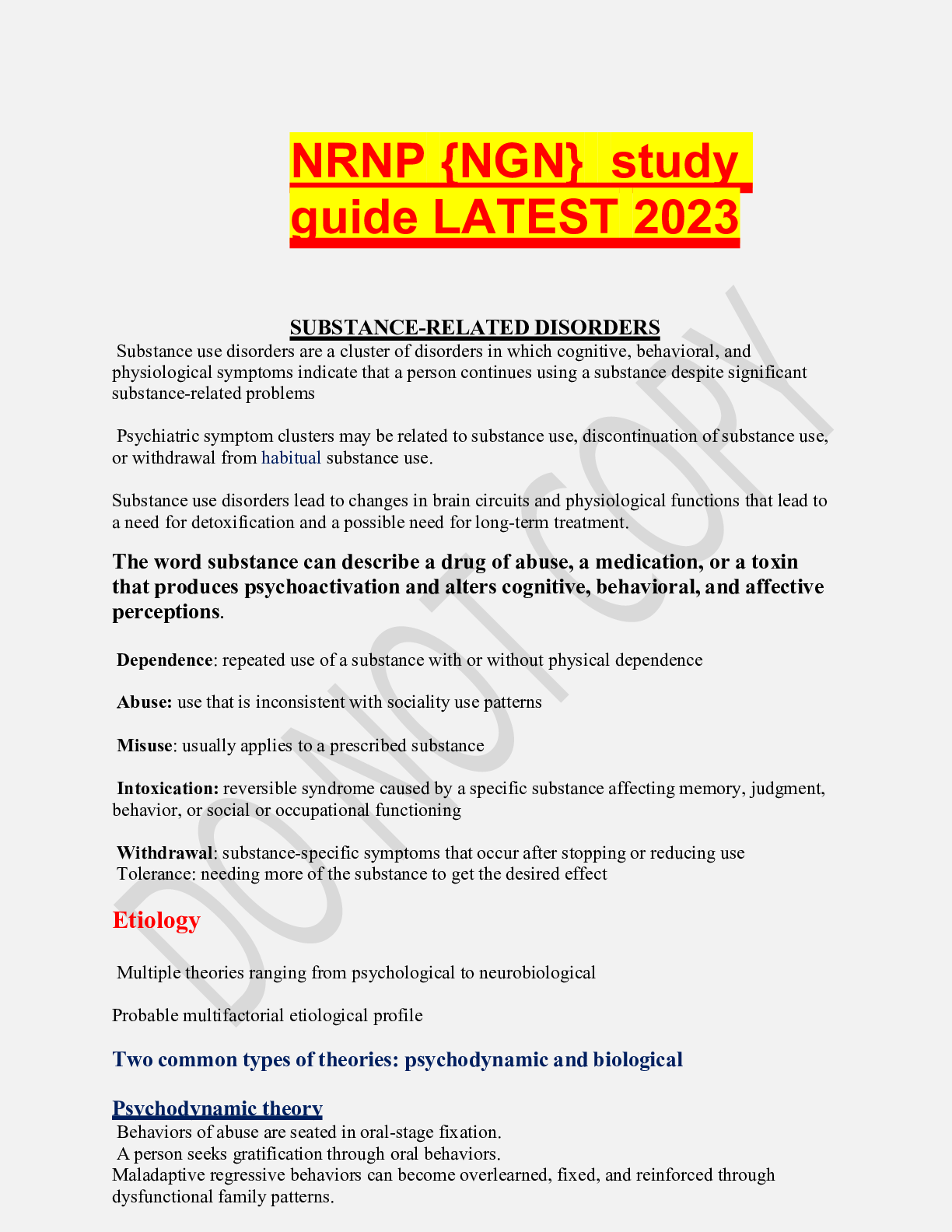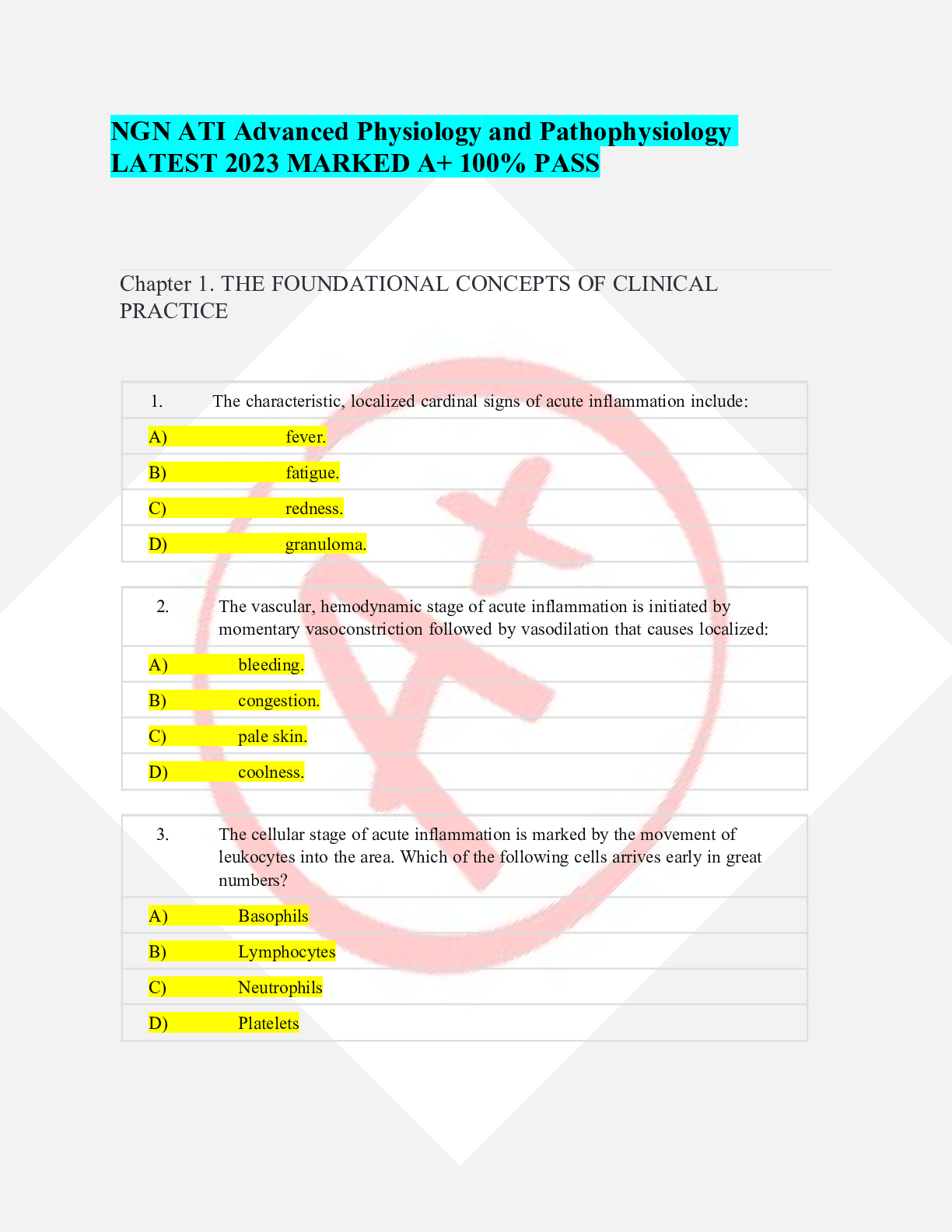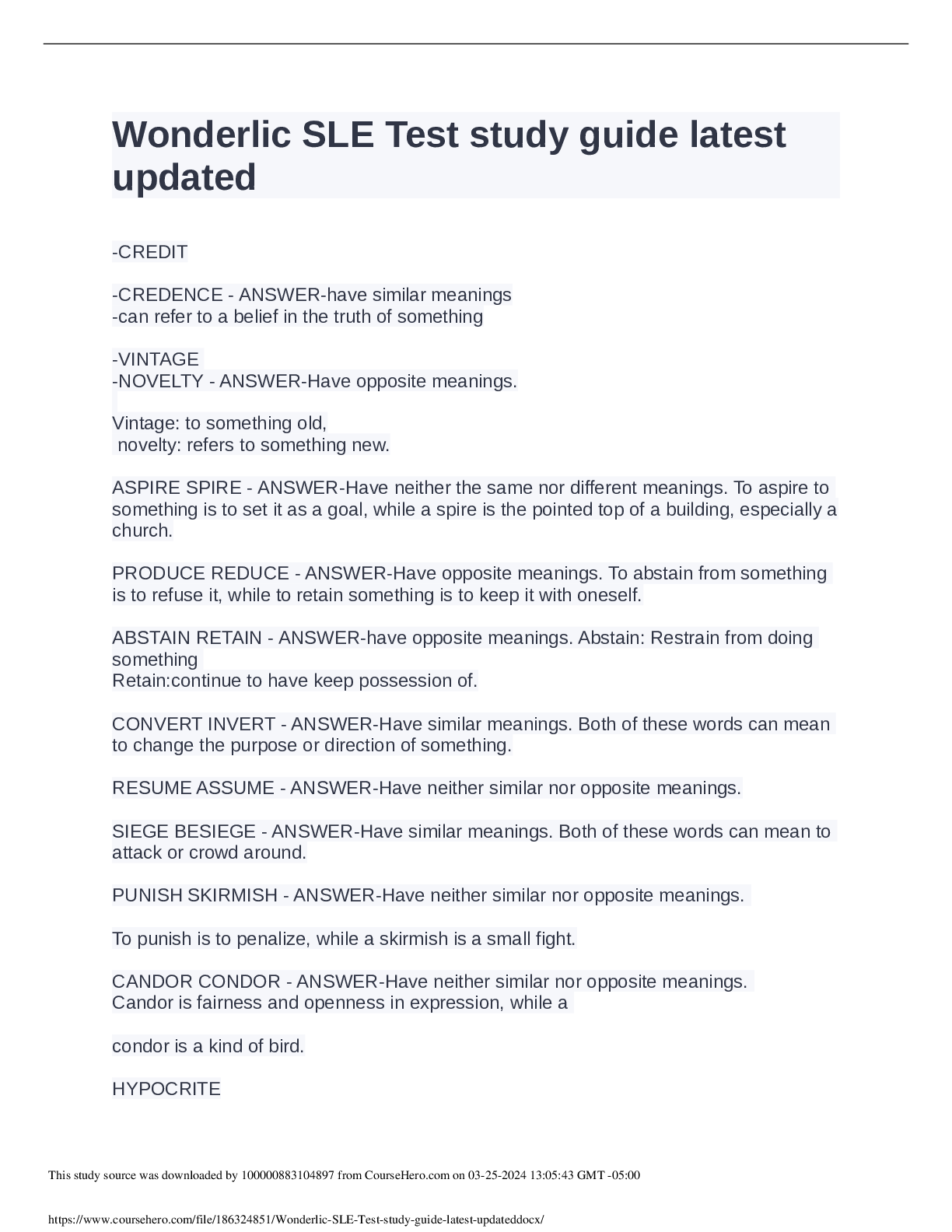*NURSING > ASSIGNMENT > NRNP {NGN} study guide LATEST 2023 (All)
NRNP {NGN} study guide LATEST 2023
Document Content and Description Below
NRNP {NGN} study guide LATEST 2023 SUBSTANCE-RELATED DISORDERS Substance use disorders are a cluster of disorders in which cognitive, behavioral, and physiological symptoms indicate that a pe... rson continues using a substance despite significant substance-related problems Psychiatric symptom clusters may be related to substance use, discontinuation of substance use, or withdrawal from habitual substance use. Substance use disorders lead to changes in brain circuits and physiological functions that lead to a need for detoxification and a possible need for long-term treatment. The word substance can describe a drug of abuse, a medication, or a toxin that produces psychoactivation and alters cognitive, behavioral, and affective perceptions. Dependence: repeated use of a substance with or without physical dependence Abuse: use that is inconsistent with sociality use patterns Misuse: usually applies to a prescribed substance Intoxication: reversible syndrome caused by a specific substance affecting memory, judgment, behavior, or social or occupational functioning Withdrawal: substance-specific symptoms that occur after stopping or reducing use Tolerance: needing more of the substance to get the desired effect Etiology Multiple theories ranging from psychological to neurobiological Probable multifactorial etiological profile Two common types of theories: psychodynamic and biological Psychodynamic theory Behaviors of abuse are seated in oral-stage fixation. A person seeks gratification through oral behaviors. Maladaptive regressive behaviors can become overlearned, fixed, and reinforced through dysfunctional family patterns. Sociocultural factors attempt to explain population-based differences in substance abuse rates. Biological theory Genetic loading People with a strong genetic vulnerability to addiction are thought to have defects in the working of the reward center of the brain, which predisposes them to stronger-than-normal positive rewards that draw them to substance use. Gender differences Ethnic differences A person is predisposed to stronger-than-normal negative rewards, making it more difficult to stop abuse once it has begun. Involves two neurobiological processes: 1.Reinforcement Brain-based changes in structure and function can lead to addictive behavior. The process of positive and negative rewards is physiologically linked to memory function. Changes appear to occur with any drug of abuse. Reinforcement results in “feel good” sensations when a drug of abuse is used and in “feel bad” sensations when the drug exits the body. Positive rewards of reinforcement result in the social rewards commonly associated with drug use, such as disinhibition, euphoric mood, and anxiety reduction. Mediated by dopamine (DA) pathways. Negative rewards are aversive, such as increased anxiety and dysphoria. Mediated by the gamma amino butyric acid (GABA) pathways . Reinforcement occurs in the ventral tegmental area and the nucleus accumbens of the brain, collectively called the reward center. DA release within the reward center is enhanced further by the release of natural morphine-like neurotransmitters called neuropeptides (enkephalins, beta-endorphins). Neuropeptides further enhance the reinforcing pleasure experienced by the person. With repeated drug use, the DA system becomes increasingly sensitized. Eventually, associated drug use stimuli (e.g., pictures of drug paraphernalia) can cause DA release, leading to reinforcement of use and often to increased drug use. 2.Neuroadaptation Brain-based changes in structure and function can lead to tolerance and withdrawal. Drug-specific alterations in the normal level and function of neurotransmitters occur as the body adapts to the chronic presence of the substance of abuse. Neuroadaptive processes become very significant when the person stops substance use. These processes become the basis for withdrawal symptoms, because adaptive responses are unopposed when the substance is no longer present. Neuroadaptive changes may be more enduring in some persons, possibly lasting for years, thus increasing their potential for relapse. This concept helps to explain why, after a long period of sobriety, a person who returns to substance abuse often picks up at the same level of tolerance and physical impact as experienced before sobriety. Incidence and Demographics Persons age 18 to 24 years of age have high prevalence rates for using most substances. The United States has higher rates of substance use than any other developed country. More than 50% of U.S. clients with a psychiatric disorder have a comorbid substance use disorder. Persons with schizophrenia are 4 times more likely to have a substance use comorbidity than the general population. Persons with bipolar affective disorder are 5 times more likely to have a substance use comorbidity than the general population. More than 2 million admissions annually are made to inpatient substance use treatment facilities. Though now legal in some states, marijuana is the most commonly abused illegal substance. Alcohol is the most commonly abused legal substance. [Show More]
Last updated: 11 months ago
Preview 1 out of 24 pages
Instant download

Buy this document to get the full access instantly
Instant Download Access after purchase
Add to cartInstant download
Reviews( 0 )
Document information
Connected school, study & course
About the document
Uploaded On
Jul 01, 2023
Number of pages
24
Written in
Additional information
This document has been written for:
Uploaded
Jul 01, 2023
Downloads
0
Views
55




